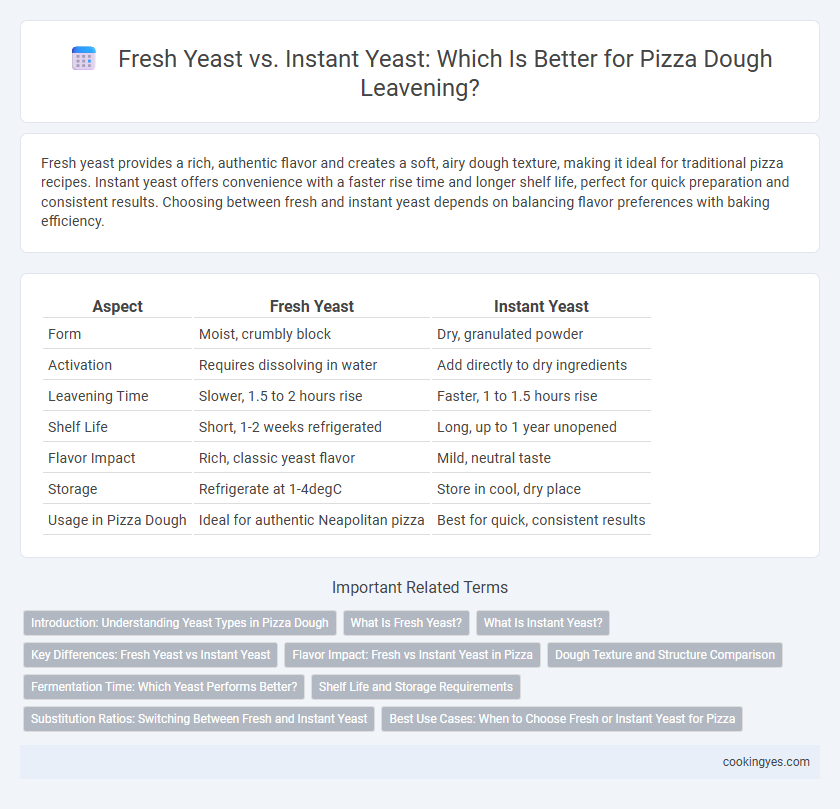Fresh yeast provides a rich, authentic flavor and creates a soft, airy dough texture, making it ideal for traditional pizza recipes. Instant yeast offers convenience with a faster rise time and longer shelf life, perfect for quick preparation and consistent results. Choosing between fresh and instant yeast depends on balancing flavor preferences with baking efficiency.
Table of Comparison
| Aspect | Fresh Yeast | Instant Yeast |
|---|---|---|
| Form | Moist, crumbly block | Dry, granulated powder |
| Activation | Requires dissolving in water | Add directly to dry ingredients |
| Leavening Time | Slower, 1.5 to 2 hours rise | Faster, 1 to 1.5 hours rise |
| Shelf Life | Short, 1-2 weeks refrigerated | Long, up to 1 year unopened |
| Flavor Impact | Rich, classic yeast flavor | Mild, neutral taste |
| Storage | Refrigerate at 1-4degC | Store in cool, dry place |
| Usage in Pizza Dough | Ideal for authentic Neapolitan pizza | Best for quick, consistent results |
Introduction: Understanding Yeast Types in Pizza Dough
Fresh yeast and instant yeast are two primary leavening agents used in pizza dough, each offering distinct characteristics that impact dough texture and rise time. Fresh yeast contains live yeast cells with a higher moisture content, promoting a strong, slow fermentation that enhances flavor complexity in traditional dough. Instant yeast, dehydrated and finely granulated, activates rapidly, providing quicker leavening for efficient dough preparation without compromising rise quality.
What Is Fresh Yeast?
Fresh yeast, also known as cake yeast or compressed yeast, is a moist, perishable form of yeast commonly used in traditional pizza dough recipes for its ability to produce a light, airy texture and rich flavor. It consists of live Saccharomyces cerevisiae cells packed in a soft, crumbly cake that requires refrigeration and has a shorter shelf life compared to instant yeast. Fresh yeast activates quickly when dissolved in warm water, making it ideal for slower dough fermentation processes that enhance gluten development and overall dough quality.
What Is Instant Yeast?
Instant yeast is a fast-acting dry yeast commonly used in pizza dough for its ability to ferment sugars quickly, producing carbon dioxide that leavens the dough efficiently. Unlike fresh yeast, which requires refrigeration and has a shorter shelf life, instant yeast is shelf-stable and can be mixed directly into flour without dissolving in water first. This yeast variety enhances dough rise time and consistency, making it ideal for consistent, high-quality pizza crusts.
Key Differences: Fresh Yeast vs Instant Yeast
Fresh yeast contains about 70% moisture, offering a shorter fermentation time and a softer dough texture, whereas instant yeast is dried with low moisture for longer shelf life and faster activation. Fresh yeast requires refrigeration and dissolving in liquid before use, while instant yeast can be directly mixed with flour due to its granulated form. Both yeasts effectively leaven pizza dough but differ in handling, fermentation speed, and flavor development during baking.
Flavor Impact: Fresh vs Instant Yeast in Pizza
Fresh yeast enhances pizza dough with a richer, more complex flavor due to its higher moisture content and shorter fermentation time, producing subtle aromatic compounds that elevate the taste. Instant yeast, while offering convenience and faster proofing, generally results in a milder flavor profile with less depth, which can make the crust taste more neutral. Choosing fresh yeast benefits artisan-style pizzas seeking nuanced flavor, whereas instant yeast suits quick recipes prioritizing efficiency.
Dough Texture and Structure Comparison
Fresh yeast creates a dough with a more open crumb structure and slightly chewier texture due to its higher moisture content and slower fermentation process. Instant yeast produces a tighter, more uniform crumb with a softer texture, as it ferments faster and generates more gas quickly. The choice between fresh and instant yeast directly impacts the dough's elasticity, rise time, and final crust crispness in pizza preparation.
Fermentation Time: Which Yeast Performs Better?
Fresh yeast typically requires a longer fermentation time of 8 to 12 hours due to its higher moisture content and slower activation, resulting in a more complex flavor profile for pizza dough. Instant yeast activates faster and can leaven dough in as little as 1 to 2 hours, making it ideal for quicker preparation but sometimes yielding less depth in taste. Choosing between fresh yeast and instant yeast depends on the desired fermentation time and flavor intensity for the final pizza crust.
Shelf Life and Storage Requirements
Fresh yeast has a short shelf life of about 1 to 2 weeks and requires refrigeration at 2-6degC to maintain its potency, making it less convenient for long-term storage. Instant yeast, also known as active dry yeast, offers a longer shelf life of up to 1-2 years when stored in a cool, dry place, typically at room temperature. Due to its stability and ease of storage, instant yeast is often preferred for pizza dough leavening in both home and professional kitchens.
Substitution Ratios: Switching Between Fresh and Instant Yeast
When substituting fresh yeast with instant yeast for pizza dough, use a ratio of 1:0.4, meaning 10 grams of fresh yeast equals 4 grams of instant yeast. Instant yeast absorbs water faster and acts more efficiently, so reduce the quantity compared to fresh yeast to avoid over-leavening. Adjust dough hydration slightly when swapping yeasts to maintain optimal texture and rise during fermentation.
Best Use Cases: When to Choose Fresh or Instant Yeast for Pizza
Fresh yeast provides a subtle, complex flavor ideal for slow fermentation in artisan pizza doughs, enhancing texture and depth when dough rests for several hours or overnight. Instant yeast offers rapid fermentation and consistency, making it perfect for quick pizza recipes requiring same-day preparation and reliable rise. Choosing between the two depends on desired fermentation time and flavor profile, with fresh yeast preferred for extended proofing and instant yeast for fast, efficient dough leavening.
Fresh yeast vs Instant yeast for dough leavening Infographic

 cookingyes.com
cookingyes.com